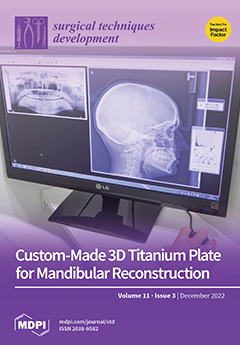Objective: To explore the surgical effect of three-dimensional (3D) image reconstruction technology in pancreatoduodenectomy.
Methods: The clinical records of 47 cases who underwent pancreatoduodenectomy between January 2018 and December 2019 at the department of hepatobiliary surgery of the General Hospital of Ningxia Medical
[...] Read more.
Objective: To explore the surgical effect of three-dimensional (3D) image reconstruction technology in pancreatoduodenectomy.
Methods: The clinical records of 47 cases who underwent pancreatoduodenectomy between January 2018 and December 2019 at the department of hepatobiliary surgery of the General Hospital of Ningxia Medical University were retrospectively examined, including 23 males and 24 females, with an average age of 55.00 ± 10.06 years. All patients underwent enhanced computed tomography (CT), and the 3D images were reconstructed by uploading the CT imaging data. The pre-operation evaluation and treatment strategy were planned according to CT imaging and 3D data, respectively. The change of treatment strategy based on 3D evaluation, actual surgical procedure, tumor volume measured by 3D model, actual tumor volume, variants of hepatic artery, operation time, intraoperative blood loss, post-operation hospital stay and post-operation complications was recorded.
Results: The treatment strategies were changed after 3D visualization in 10 (21.3%) out of 47 patients because of blood vessel and organ invasion by tumor. The surgical procedure was changed in three cases, and the surgical procedure was optimized and improved in seven cases. All surgical plans based on 3D visualization technology were matched with the actual surgical procedures. Tumor volume measured by 3D model was 19.69 ± 23.47 mL, post-operation actual tumor volume was 17.07 ± 20.29 mL, with no significant difference between them (t = 0.54,
p = 0.59). Pearson’s correlation analysis showed statistical significance (r = 0.766,
p = 0.00). The average operation time was 4.85 ± 1.75 h, median blood loss volume was 447.05 (50–5000) mL, and post-operation hospital stay was 26.13 ± 11.13 days. Six cases had pancreatic fistula, two cases had biliary leakage, and four cases had delayed gastric emptying. Ascites and pleural effusion was observed in three cases.
Conclusions: 3D visualization technology can offer a precise and individualized surgical plan before operation, which might improve the safety of pancreatoduodenectomy, and has application value in preoperative planning.
Full article




